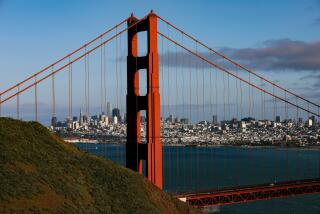Oil Spill Still a Threat to Bird Breeding Site
- Share via
SAN FRANCISCO — An oil spill of unknown origin appeared Wednesday to be breaking up off the San Mateo County coast, but still posed a threat to a key breeding ground for seabirds and the shore near Half Moon Bay, a Coast Guard spokesman said.
The spill was detected in the shipping lanes 10 miles west of the Golden Gate Bridge on Sunday afternoon, but by Wednesday afternoon had drifted south, as close as two miles from the Half Moon Bay shore. Two Coast Guard ships were scooping up clumps and balls of tar from the water.
Volunteers scouring the coast from Ano Nuevo to San Francisco found about 30 live, oiled birds and two dozen dead birds, Coast Guard Petty Officer Paul Rhynard said.
“We have about 157 people working on this. We are taking it very seriously,” Rhynard said. But he said that the spilled oil already had broken up into patches of tar and oil rather than a single slick, and no significant amounts had washed ashore.
“We have a ship that is scooping up oil two miles from shore, and another ship that is scooping it up 10 miles from shore, and the water in between is clean,” Rhynard said. Investigators are analyzing oil samples and will attempt to match it with ships known to be in the area at the time of the spill, he said.
By Wednesday afternoon, Coast Guard ships had scooped up 210 gallons of oil and tar. A low cloud cover off the coast made it hard to gauge how much oil was in the water, Rhynard said. But Dana Michael, a spokeswoman for the California Department of Fish and Game, told the Associated Press that 2,300 gallons of oil had been spilled.
That would be far less than the 70,000 gallons of oil released in October 1996 from the ship Cape Mohican into San Francisco Bay. And it would be minuscule compared to the 1990 Huntington Beach spill of 399,000 gallons of crude oil or the 10.1-million-gallon Exxon Valdez spill into Prince William Sound, Alaska in March 1989.
But the spill is dangerous because it occurred in such a sensitive spot, said Ed Ueber, manager of the Gulf of the Farallones National Marine Sanctuary, where the spill was first detected.
Two small tar ball spills off Point Reyes, north of San Francisco, in the fall of 1997 and the spring of 1998 killed 10,000 to 20,000 seabirds, Ueber said. The Coast Guard is still trying to determine what caused those spills, he said.
Ueber described the Farallones as “the largest and most diverse breeding ground for seabirds in the continental United States.” Its wave-washed rocks and feeding grounds are a key stopover on the Pacific flyway for migrating seabirds.
Sunday’s spill did not occur during breeding season, but there are hundreds of thousands of pelicans, common murres, sooty shearwaters, cormorants, endangered marbled murrelets and brown pelicans feeding off the coast in the threatened area, Ueber said.
“We found more birds on Tuesday than we did on Monday and more Wednesday than we did on Monday and Tuesday combined,” he said. “It is impossible to say whether it has peaked or will grow.”
Volunteers and crews from the Coast Guard and Fish and Game department have found dozens of birds so far, mostly common murres, coated with oil.
The spill occurred one day before Gov. Pete Wilson signed legislation prohibiting large transport ships from entering state waters unless the owner or operator has an approved oil spill contingency plan.
More to Read
Sign up for Essential California
The most important California stories and recommendations in your inbox every morning.
You may occasionally receive promotional content from the Los Angeles Times.













